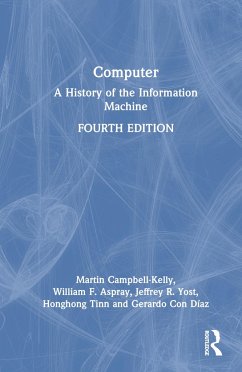Martin Campbell-Kelly, William F Aspray, Jeffrey R Yost, Honghong Tinn, Gerardo Con Díaz
Computer
A History of the Information Machine
Martin Campbell-Kelly, William F Aspray, Jeffrey R Yost, Honghong Tinn, Gerardo Con Díaz
Computer
A History of the Information Machine
- Gebundenes Buch
- Merkliste
- Auf die Merkliste
- Bewerten Bewerten
- Teilen
- Produkt teilen
- Produkterinnerung
- Produkterinnerung
Computer: A History of the Information Machine traces the history of the computer and its unlimited, information-processing potential.
Andere Kunden interessierten sich auch für
![History History]() Peter ClausHistory168,99 €
Peter ClausHistory168,99 €![Conscience, Government and War Conscience, Government and War]() Rachel BarkerConscience, Government and War120,99 €
Rachel BarkerConscience, Government and War120,99 €![Out of Step Out of Step]() Joseph TrenamanOut of Step139,99 €
Joseph TrenamanOut of Step139,99 €![Ministry of Morale Ministry of Morale]() Ian McLaineMinistry of Morale165,99 €
Ian McLaineMinistry of Morale165,99 €![A Modern History of Forgotten Genocides and Mass Atrocities A Modern History of Forgotten Genocides and Mass Atrocities]() A Modern History of Forgotten Genocides and Mass Atrocities179,99 €
A Modern History of Forgotten Genocides and Mass Atrocities179,99 €![War and Warfare Since 1945 War and Warfare Since 1945]() Sterling PavelecWar and Warfare Since 1945181,99 €
Sterling PavelecWar and Warfare Since 1945181,99 €![War in the Modern World Since 1815 War in the Modern World Since 1815]() Jeremy Black (ed.)War in the Modern World Since 1815187,99 €
Jeremy Black (ed.)War in the Modern World Since 1815187,99 €-
-
-
Computer: A History of the Information Machine traces the history of the computer and its unlimited, information-processing potential.
Hinweis: Dieser Artikel kann nur an eine deutsche Lieferadresse ausgeliefert werden.
Hinweis: Dieser Artikel kann nur an eine deutsche Lieferadresse ausgeliefert werden.
Produktdetails
- Produktdetails
- Verlag: Taylor & Francis
- 4th edition
- Seitenzahl: 384
- Erscheinungstermin: 19. Juni 2023
- Englisch
- Abmessung: 229mm x 152mm x 22mm
- Gewicht: 694g
- ISBN-13: 9781032203478
- ISBN-10: 1032203471
- Artikelnr.: 67514787
- Herstellerkennzeichnung
- Libri GmbH
- Europaallee 1
- 36244 Bad Hersfeld
- gpsr@libri.de
- Verlag: Taylor & Francis
- 4th edition
- Seitenzahl: 384
- Erscheinungstermin: 19. Juni 2023
- Englisch
- Abmessung: 229mm x 152mm x 22mm
- Gewicht: 694g
- ISBN-13: 9781032203478
- ISBN-10: 1032203471
- Artikelnr.: 67514787
- Herstellerkennzeichnung
- Libri GmbH
- Europaallee 1
- 36244 Bad Hersfeld
- gpsr@libri.de
Martin Campbell-Kelly is Professor Emeritus in the Department of Computer Science at Warwick University. His most recent book is Cellular: An Economic and Business History of the International Mobile-Phone Industry (with Daniel Garcia-Swartz, 2022). William F. Aspray is a Senior Research Fellow at the Charles Babbage Institute, University of Minnesota. His recent books include Fake News Nation: The Long History of Lies and Misinterpretations in America (with James Cortada, 2019). Jeffrey R. Yost is Director of the Charles Babbage Institute and Research Professor in the Program in the History of Science, Technology, and Medicine, at the University of Minnesota. His books include Making IT Work: A History of the Computer Services Industry (2017). Honghong Tinn is Assistant Professor in the Program in the History of Science, Technology, and Medicine and the Department of Electrical and Computer Engineering at the University of Minnesota. Her works on the history and globalization of information technology have been published in Technology and Culture, IEEE Annals of the History of Computing, and Osiris. Gerardo Con Díaz is Associate Professor in the Department of Science and Technology Studies at the University of California, Davis. He is the author of Software Rights: How Patent Law Transformed Software Development in America (2019) and has held fellowships at Yale Law School and the Hoover Institution, Stanford University.
Part 1: BEFORE THE COMPUTER 1. When Computers Were People 2. The Mechanical
Office 3. Babbage's Dream Comes True Part 2: CREATING THE COMPUTER 4.
Inventing the Computer 5. The Computer Becomes a Business Machine 6. The
Maturing of the Mainframe: The Rise of IBM Part 3: INNOVATION AND EXPANSION
7. Real Time: Reaping the Whirlwind 8. Software 9. New Modes of Computing
Part 4: GETTING PERSONAL 10. The Shaping of the Personal Computer 11.
Broadening the Appeal 12. The Internet Part 5: THE UBIQUITOUS COMPUTER 13.
Globalization 14. The Interactive Web: Clouds, Devices, and Culture 15.
Computing and Governance
Office 3. Babbage's Dream Comes True Part 2: CREATING THE COMPUTER 4.
Inventing the Computer 5. The Computer Becomes a Business Machine 6. The
Maturing of the Mainframe: The Rise of IBM Part 3: INNOVATION AND EXPANSION
7. Real Time: Reaping the Whirlwind 8. Software 9. New Modes of Computing
Part 4: GETTING PERSONAL 10. The Shaping of the Personal Computer 11.
Broadening the Appeal 12. The Internet Part 5: THE UBIQUITOUS COMPUTER 13.
Globalization 14. The Interactive Web: Clouds, Devices, and Culture 15.
Computing and Governance
Part 1: BEFORE THE COMPUTER 1. When Computers Were People 2. The Mechanical Office 3. Babbage's Dream Comes True Part 2: CREATING THE COMPUTER 4. Inventing the Computer 5. The Computer Becomes a Business Machine 6. The Maturing of the Mainframe: The Rise of IBM Part 3: INNOVATION AND EXPANSION 7. Real Time: Reaping the Whirlwind 8. Software 9. New Modes of Computing Part 4: GETTING PERSONAL 10. The Shaping of the Personal Computer 11. Broadening the Appeal 12. The Internet Part 5: THE UBIQUITOUS COMPUTER 13. Globalization 14. The Interactive Web: Clouds, Devices, and Culture 15. Computing and Governance
Part 1: BEFORE THE COMPUTER 1. When Computers Were People 2. The Mechanical
Office 3. Babbage's Dream Comes True Part 2: CREATING THE COMPUTER 4.
Inventing the Computer 5. The Computer Becomes a Business Machine 6. The
Maturing of the Mainframe: The Rise of IBM Part 3: INNOVATION AND EXPANSION
7. Real Time: Reaping the Whirlwind 8. Software 9. New Modes of Computing
Part 4: GETTING PERSONAL 10. The Shaping of the Personal Computer 11.
Broadening the Appeal 12. The Internet Part 5: THE UBIQUITOUS COMPUTER 13.
Globalization 14. The Interactive Web: Clouds, Devices, and Culture 15.
Computing and Governance
Office 3. Babbage's Dream Comes True Part 2: CREATING THE COMPUTER 4.
Inventing the Computer 5. The Computer Becomes a Business Machine 6. The
Maturing of the Mainframe: The Rise of IBM Part 3: INNOVATION AND EXPANSION
7. Real Time: Reaping the Whirlwind 8. Software 9. New Modes of Computing
Part 4: GETTING PERSONAL 10. The Shaping of the Personal Computer 11.
Broadening the Appeal 12. The Internet Part 5: THE UBIQUITOUS COMPUTER 13.
Globalization 14. The Interactive Web: Clouds, Devices, and Culture 15.
Computing and Governance
Part 1: BEFORE THE COMPUTER 1. When Computers Were People 2. The Mechanical Office 3. Babbage's Dream Comes True Part 2: CREATING THE COMPUTER 4. Inventing the Computer 5. The Computer Becomes a Business Machine 6. The Maturing of the Mainframe: The Rise of IBM Part 3: INNOVATION AND EXPANSION 7. Real Time: Reaping the Whirlwind 8. Software 9. New Modes of Computing Part 4: GETTING PERSONAL 10. The Shaping of the Personal Computer 11. Broadening the Appeal 12. The Internet Part 5: THE UBIQUITOUS COMPUTER 13. Globalization 14. The Interactive Web: Clouds, Devices, and Culture 15. Computing and Governance









